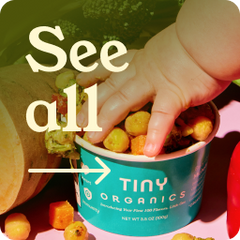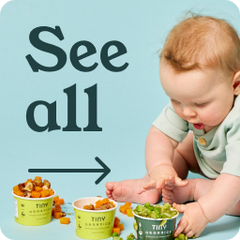When New Means No: 5 Key Takeaways from Experts

Making sure your child has a nutritious start to life and learning how to help them develop positive eating habits can be hard with busy schedules and conflicting information from books, blogs, and videos. Our expert panelists give practical advice on how to approach picky eating, technology, nutrition, and early childhood development.
Our Experts:
Hildy Lipner: Chief of Pediatric Speech and Language Pathology at the Institute for Child Development at the Joseph M. Sanzari Children’s Hospital and Hackensack University Medical Center.
Karin Gibson: Swedish dietician located in New York City who runs a private practice, Grazing Greens, focused on prenatal and child nutrition.
Peggy Rodriguez: Head of Admissions at Eladia’s Daycare, a premier early childhood education center with six locations in Brooklyn.
1. Technology Can Negatively Impact Childhood Development and Eating Habits
"The American Academy of Pediatrics says no screen time before the age of two and minimal screen time during early childhood years. Sitting your child in front of a screen when they're eating is definitely something to avoid. Eating is a sensory activity. We learn about food while eating. Learn about how it feels in our mouth, how it tastes. Eating is also a social activity. When eating becomes the secondary activity, you miss out on learning about the sensory properties of food, how to manipulate food in your mouth and the social aspects of family mealtime” – Hildy Lipner
Takeaway: During mealtime, it’s important to limit distractions like TV or phone and iPad games. When your child is learning how to eat and is tasting new foods for the first time, they need to use their senses to touch, play, and eat their food. When the TV is playing during mealtimes your child is no longer an active participant in mealtime and watching TV while eating becomes an unhealthy habit.
2. “New Means No”
"As adults, we have very, very mature palates. We've been eating for a long time -- we know what we like and what we don't, so it is easy to make a quick decision when presented with an unfamiliar taste. Kids' palates are much less developed and consequently, they like what is familiar and anticipated. I always tell people that my mantra with kids is that typically 'new means no.'" – Hildy Lipner
Takeaway: It can be difficult to get your child to try something new. It can often take 10-20+ times of exposing your child to a new food before they eat it. A positive method to introduce a new food into your child’s diet is to present them with age-appropriate portions of 2-3 foods that you know they will eat and a smaller helping of a new food you would like your child to eat. Children can be reluctant to try unfamiliar foods, and it’s important that when introducing a new food into your child’s diet that you continue to present it as part of their meal every few days, talk about it, see others eat it and give the child time to become “familiar” with the food even if they won’t try or don’t like the new food at first.
3. Exposure does not = eating
“I've had families who think exposure means they have to have it in their mouth. But actually, the 30 exposure times you referenced, some of those types can just be squashing the food, playing with it or even just seeing it on the plate.” - Karin Gibson
Takeaway: Even if your child doesn’t eat a new food, it’s important for them to see, smell, and touch it. Exposure doesn’t equal eating! It can take a while before your child is willing to put new food into their mouth. However, engaging your child’s other senses will make them more comfortable and familiar with new foods.
4. Your child's palate is not going to expand beyond yours
“Don't be afraid of spices. If you do takeout, try out a whole bunch of different cuisines with different flavors! The more foods you get into their mouth before they are 12 months the easier it's going to be later on.” - Karin Gibson
Takeaway: Introducing your child to spices, different cuisine, and even food you may not like is very important in developing your child’s palate. Your baby is only exposed to the spices and the types of foods that you cook for them. By giving your child a small taste of your food, your child can experience new spices that they may not otherwise eat. This can help reduce the risk of picky eating later in life!
5. Picky Eaters: there's a difference between “can’t” and won’t”
Dealing with your typical picky eater who “won’t” eat a variety of foods can be a frustrating experience, for both kids and parents alike. Our experts agree that when dealing with picky eaters:
1. Don’t offer rewards for cooperation: This gives your child too much control over mealtimes, and the price of cooperation is likely to increase.
2. Use a divided plate for meals: If your child won’t accept one of the foods you’ve made, they will continue to eat the 2-3 portions of the other familiar and accepted foods you’ve prepared. Second helpings of preferred foods only come after the whole plate is empty. Hunger can often be your friend and may tempt your child to try the last food left on their plate. Remember portions of the new food should start out much smaller to give your child the best opportunity for success, when learning to “taste” and accept a new food.
3. Use positive language when talking about your child and eating: When explaining that your child may be a picky eater and may not eat certain foods, using phrases like “she doesn’t like that” or “he won’t eat that” only reinforces refusals and picky eating behavior. Instead, use phrases like “we are actually trying out some different foods right now.” This removes blame and judgment and sets up mealtimes to be more fun and adventurous.
*One Very Important Thing To Note: It’s important to realize that some children who are “picky eaters” actually “can’t” progress and may have an underlying reason or medical condition that perpetuates their attitude toward eating. Some children may need guidance from a speech pathologist trained in helping children with eating disorders to help them learn to accept food textures and manipulate them in their mouth. When a child’s diet becomes so limited that they aren’t getting the proper nutrition it’s important that you seek the advice of a medical professional. Picky eating isn’t always a behavioral issue, and your child may be unable to explain that eating can often be followed by mild stomach discomfort or pain. If your child is “beyond” picky, often seems to have no appetite and frequently refuses to eat they could have a food sensitivity, intolerance, or allergy that is negatively affecting their eating and can only be addressed and treated by a medical professional. Voicing your concerns regarding your child’s restrictive eating patterns with your child’s pediatrician is recommended. – Hildy Lipner



















